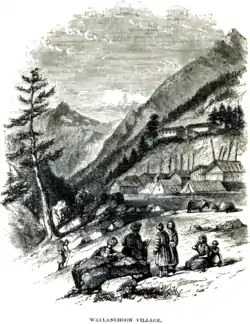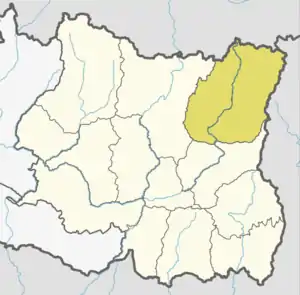Olangchung Gola
Olangchung Gola (locally as Walung or Holung, historically transcribed as Wallanchoon) is a village (previously: a village development committee) in ward no. 7 of Phaktanglung rural municipality of Taplejung District of Province No. 1 in Nepal. Olangchung is surrounded by Lelep village to the east and Tibet to the north, Sankhuwasabha District to west and Mikkwakhola rural municipality to south. It is located to the north of Tamor River in the mountainous area in the northwest of Taplejung District bordering Tibet, China. Lately the river flowing next to the village is gradually expanding towards the village posing a serious threat of submerging the village.
Olangchung Gola
ओलाङ्चुङ गोला Walungchung Gola | |
|---|---|
 "Wallanchoon Village" illustration made by Joseph Dalton Hooker during his 1847–1851 Himalayan expedition | |
 Olangchung Gola Location in Nepal | |
| Coordinates: 27.6792°N 87.7792°E | |
| Country | |
| Province | Province No. 1 |
| District | Taplejung District |
| Rural municipality | Phaktanglung |
| Ward No. | 7 (७) |
| Government | |
| • Type | Ward |
| • Commissioner | Chheten Sherpa Bhote |
| Area | |
| • Total | 701.50 km2 (270.85 sq mi) |
| Population (2011) | |
| • Total | 239 |
| • Density | 0.34/km2 (0.88/sq mi) |
| Time zone | UTC+5:45 (Nepal Time) |
| Postal code | 57508 |
| Area code(s) | 024 |
Olangchung Gola is the last village before crossing the Lumbasumba La pass to the west to the remote village of Thudam along the high Great Himalayan Trail system. There is one lodge for trekkers with camping space in Olangchung Gola.
Etymology
Gola means "market" in the local language.[1][2] In fact, the name "Olangchung" came from a folklore involving a wolf and a trader.[3]
History
The area was once a strategic place between Tibet, Nepal and Sikkim.[4] Historically Tipta La the pass connecting the area with Tibet was an important trade route.[5] In addition, Olangchung Gola was the trade hub for surrounding villages such as Yangma, Ghunsa, Khangbachey, Lungthung, Lelep.[4][1]
The Gorkha war between Nepal and Tibet was negotiated in this tiny village. The Chogyal of Sikkim, fearing incarceration by British India, went into hiding here, ready to escape into Tibet, though he was captured later.
Transportation
In late 2016, China built a road connection on their side to the border at Tiptala Bhanjyang (Tipta La).[6] In June 2017, Chinese construction crew constructed a dirt track from the border to Olangchung Gola, the funding of which रू 30,000,000 was provided by local Nepali consumers' committee.[7] In 2019, the Chinese government allocated addition funding to upgrade the road.[8]
In the other direction, construction of the road connecting Phungling Municipality began in early 2018.[9][10]
People
The Walung people are the indigenous inhabitants of the region around Olangchung Gola.[1] They are descended from Tibetan traders and practice Nyingmapa Buddhism.
A large monastery, Deki Chholing Gompa, was built 450 years ago sits on top of the village.[11]
At the time of the 1991 Nepal census it had a population of 422 people living in 82 individual households.[12] According to 2011 Nepal census 239 people live in 62 individual households.[13]
Notable People
Dr. Sanduk Ruit a veteran ophthalmologist was born in Olangchung Gola.
References
- "Walung". National Coalition Against Racial Discrimination (Nepal). Retrieved 2017-02-14.
- Hattaway, Paul (2004). "Peoples of the Buddhist World: A Christian Prayer Diary". William Carey Library. p. 346. ISBN 9780878083619. Retrieved 2017-02-14.
- Pauler, Gerda (Nov 7, 2013). "Great Himalaya Trail: 1,700 Kilometres Across the Roof of the World". Vertebrate Publishing. Retrieved 25 November 2019.
The Name of the village originates in a folktale about a wolf (olang) that showed a trader (chun) at this place (gola) a way to Tibet.
- Schrader, Reiko (November 1987). "Trading Patterns in the Nepal Himalayas: The Case of Walongchung Gola". Internationales Asienforum. 18: 253–278. doi:10.11588/iaf.1987.18.1983. ISSN 0020-9449. Retrieved 25 November 2019.
Walongchung occupied a strategic position for trade before the 1960s
- Jackson, John Angelo (2005). "Adventure Travels in the Himalaya". Indus Publishing. ISBN 9788173871757. Retrieved 2017-02-26.
- Gautam, Anand (December 4, 2016). "China builds road up to Tiptala Bhanjyang". Kathmandu Post. Retrieved 24 November 2019.
- "Track opened to link Taplejung with China border". Kathmandu Post. July 22, 2017. Retrieved 24 November 2019.
- Gautam, Ananda (October 23, 2019). "China to upgrade dirt track that connects Tiptala Bhanjyang and Olangchungola". Kathmandu Post. Retrieved 24 November 2019.
- Ananda Gautam (March 2, 2018). "Construction of Olangchung Gola Highway begins". Kathmandu Post. Retrieved 28 December 2020.
Work related to construction of Olangchung Gola Highway, which links far eastern part of the country to Nepal-China border point, has begun.
- Ananda Gautam (December 6, 2019). "Tipta La: Paradise under the shadow". kathmandupost.com. Retrieved 28 December 2020.
The local units are currently constructing a motor track from Taplejung to Suketar to Tipta La, which will significantly ease the trip.
- Nebbs, Adam (6 Jan 2017). "Hong Kong firm offers 17-day tour of remote northeast Nepal". South China Morning Post. Retrieved 28 November 2019.
the 450-year-old Deki Chholing Gompa, which houses a trove of sacred Buddhist texts and ancient thangkas
- "Nepal Census 2001". Nepal's Village Development Committees. Digital Himalaya. Retrieved 19 November 2008.
- Households and population by village development committees/municipalities., Central Bureau of Statistics, Nepal Archived 2013-09-27 at the Wayback Machine
Steinmann, B. 1988, Les Marches tibétaines du Népal. Etat, chefferie et société traditionnels à travers le récit d'un notable népalais. Paris, l'Harmattan.

